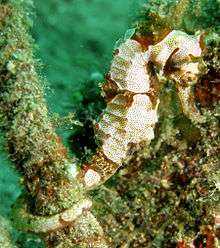Hippocampus alatus
| Hippocampus alatus | |
|---|---|
 | |
| Scientific classification | |
| Kingdom: | Animalia |
| Phylum: | Chordata |
| Class: | Actinopterygii |
| Order: | Syngnathiformes |
| Family: | Syngnathidae |
| Genus: | Hippocampus |
| Species: | H. alatus |
| Binomial name | |
| Hippocampus alatus Kuiter, 2001 | |
Hippocampus alatus, commonly known as the winged seahorse, is a marine fish belonging to the Syngnathidae family, native from the central Indo-Pacific area.
Description
The winged seahorse is a small fish that can reach a maximum length of 18 cm,[2] but an average size of around 12 cm is more common.[3]
The body is slender and elongate. The upper part of the trunk and tail have spines on their outer edges which size reduce with age. On the nape, there is a pair of spines directed outwards and covered with dermal filaments which have given its scientific and common name. The head is relatively large, the snout is long and deep. Like many seahorses, the head is provided with a certain number of characteristic spines. Thus the top of the head has a coronet composed of five to seven blunt spines, a pair of spines is also located above the eyes but smaller in size. This species has no nose spine but had one on the basis of the cheeks.
Body coloration is pale pinkish-white with numerous small dark spots. Dark reddish dermal filaments are more or less developed on the nape, the middle of the trunk, the anterior part of the tail and the head.
Distribution & habitat
The winged seahorse is widespread throughout the tropical waters of the central Indo-Pacific area from Indonesia to Philippines and also on the northern coasts of Australia.[2][1]
This seahorse likes strong current channels with soft bottoms with coral outcrops and various debris among which it can shelter and hang with his tail. It occurs at depths from 10 to 80 m deep.[2]
Biology
The winged seahorse has a carnivorous diet and is supposed to feed on small crustaceans and other planktonic organisms.[2] It is ovoviviparous and it is the male who broods the eggs in its ventral brood pouch. The latter includes villi rich in capillaries that surround each fertilized egg creating a sort of placenta supplying the embryos. Pups exit the pocket when fully grown to embark on an autonomous lifestyle.
Conservation status
This species is relatively rare and limited data on population exist. The winged seahorse is caught accidentally and considered as discarded when trawling for shrimp fishing. No information is known about the international trade of the species for the aquarium or traditional Chinese medicine markets. Because of this lack of information and the rarity of the species, it is considered as "Data Deficient" on the IUCN Red List.[1]
Internationally, it is also listed in Appendix II of the Convention on International Trade in Endangered Species of Wild Fauna and Flora (CITES) this means that it is on the list of species not necessarily threatened with extinction, but in which trade must be controlled in order to avoid utilization incompatible with their survival.
In Australia, this seahorse is also on the list of marine species of " Environment Protection and Biodiversity Conservation" (EPBC) which sets out the standards for the protection and commercialization nationally and internationally of certain species.
References
- 1 2 3 C. A. Czembor (2012). "Hippocampus alatus". IUCN Red List of Threatened Species. Version 2013.1. International Union for Conservation of Nature. Retrieved July 30, 2013.
- 1 2 3 4 "Winged Seahorse, Hippocampus alatus Kuiter 2001". Fishes of Australia.
- ↑ Kuiter, R.H. and T. Tonozuka, 2001. Pictorial guide to Indonesian reef fishes. Part 1. Eels- Snappers, Muraenidae - Lutjanidae. Zoonetics, Australia. 1-302.
